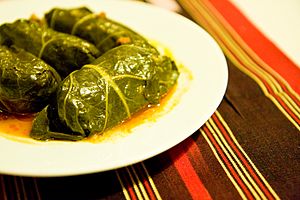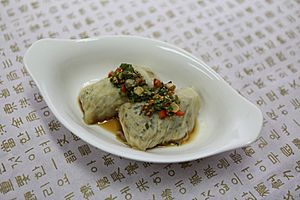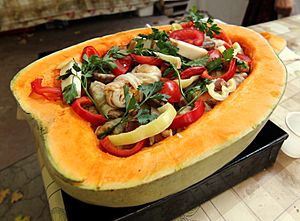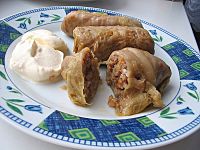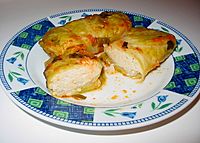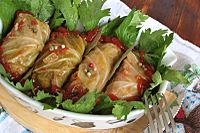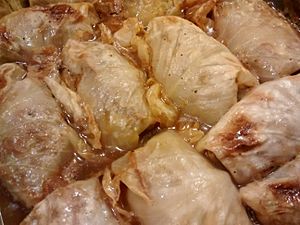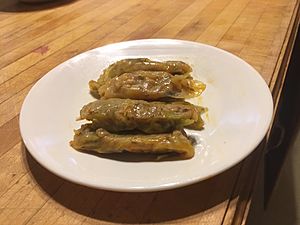Cabbage roll facts for kids
A cabbage roll is a tasty dish made from cooked cabbage leaves. These leaves are wrapped around different kinds of fillings. You can find cabbage rolls in many countries. They are popular in Central, Northern, Eastern, and Southeastern Europe. They are also common in parts of Western Asia, Northern China, and North Africa.
In Europe, people often fill cabbage rolls with meat. This can be beef, lamb, or pork. The meat is usually seasoned with garlic, onion, and other spices. Sometimes, grains like rice or barley are added. Mushrooms and vegetables are also common. In Southeastern Europe, people often use fermented (sour) cabbage leaves. In Asia, fillings can include seafood, tofu, and shiitake mushrooms. Chinese cabbage is often used for wrapping there.
After being stuffed, cabbage rolls are usually baked, simmered, or steamed. They are cooked in a covered pot and served warm. Often, they come with a sauce. The sauce changes a lot depending on the country. In Sweden and Finland, people eat them with lingonberry jam, which is both sweet and tart. In Eastern Europe, tomato sauces or sour cream are typical. In Lebanon, the rolls are small, like cigars. They are filled with rice and minced meat. They are often served with yogurt and a lemon-olive oil sauce. This sauce has garlic and dried mint.
No one knows exactly where cabbage rolls first came from. It's possible that different groups of people invented them around the same time. A Jewish version called holishkes is eaten on Simchat Torah. Some say stuffed cabbage became part of Jewish cooking about 2,000 years ago. Recipes are different in various regions. For example, Romanians and northern Poles like a savory sauce. People in Galicia and Ukraine prefer a sweet-and-sour taste. Stuffed cabbage is also a popular dish among Romani people.
Contents
Different Kinds of Cabbage Rolls
- Lahanodolmades (Λαχανοντολμάδες) – Greece
- (little pigeons) – Lithuania
- Галубцы [Halubcy] – Belarus
- Голубцы [Golubtsy] (little pigeons) – Russia
- Gołąbki (little pigeons) – Poland
- Голубці [Holubtsi] - (little pigeons) – Ukraine
- Kāpostu tīteņi – Latvia
- Holubky – Czech Republic and Slovakia
- Holishkes – Ashkenazi Jewish
- Prakas – Ashkenazi Jewish
- Krouv Memula – Israel
- Kåldolmar – Sweden
- Kaalikääryle – Finland
- Kapsarull – Estonia
- Töltött káposzta – Hungary
- Japrak or Sarma (Sarma me lakër të bardhë) – Albania
- Сарма (Sarma) – North Macedonia
- Сарма / Sarma – Serbia
- Sarma / Сарма or Japrak / Јапрак – Bosnia and Herzegovina
- Punjeni kupus or Arambašići or Sarma – Croatia
- Сарми (Sarmi; see: Sarma) – Bulgaria
- Sarmale – Romania, Moldova
- Sarma – Southeastern Europe and Turkey
- Lahana dolması/sarması – Turkey
- Kələm dolması – Azerbaijan
- Kaghambi tolma (կաղամբի տոլմա) – Armenia
- Tolma (ტოლმა) – Georgia
- Dolmeye Kalam (cabbage dolma) – Iran
- Malfoof mahshi (محشي ملفوف) – the Levant
- Mahshi kuronb (محشي كرنب) – Egypt and Sudan
- Kohlroulade and Krautwickel – Germany and Austria
- Cigares au chou – Quebec
- Involtini di cavolo – Italy
- Capuns – Graubunden, Switzerland and Lombardy, Italy
- Bragioli – Malta
- Niños Envueltos – Argentina and Uruguay
- Charuto de Repolho – Brazil
- Aluske – Paraná, Santa Catarina, and Rio Grande do Sul (Brazil)
- Bai Cai Juan (白菜卷) – China
- Rōru kyabetsu (ロールキャベツ) – Japan
- Cải bắp cuốn [Bắp cải cuốn thịt] – Vietnam
Cabbage Rolls in Europe
Azerbaijan
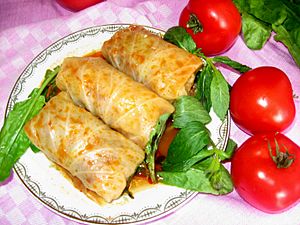
In Azerbaijan, stuffed cabbage leaves are called Kələm dolması. They are popular all year, especially in winter. The filling usually has rice, herbs like coriander, mint, and dill, onions, and meat. There is also a meat-free version called yalanchi dolma.
Balkans
Cabbage rolls are a very common food in countries like Montenegro, Bosnia and Herzegovina, Bulgaria, Macedonia, Romania, Serbia, and Croatia. People use brined (salty) cabbage leaves. They are stuffed with ground beef, pork, and rice. This dish is a favorite during Christmastime. On fasting days, meat is left out or replaced with crushed walnuts. Traditionally, these rolls are simmered for a long time. They cook in a paprika-based sauce with smoked bacon.
Romania and Moldova
Sarmale are Romanian stuffed cabbage rolls. They are traditionally served on Christmas and New Year's Eve. But people also eat them at weddings and other big parties all year. Ground pork is mixed with cooked onions and rice. This mix is stuffed into a cabbage leaf, pickled sauerkraut leaf, or grape leaf. For extra flavor, layers of smoked pork fat, smoked ribs, or smoked sausage are often added.
Romanian sarmale can be made in different ways. The flavor can change a lot. They can have a tomato base or a dill base. Sometimes, sweet shredded cabbage is layered between the rolls. Or, sauerkraut layers are put between sweet cabbage leaves. Each way gives a different but still delicious taste.
Hungary
The traditional Hungarian cabbage roll is called töltött káposzta. It can be made with sweet or sauerkraut cabbage leaves. The filling is a mix of minced pork, eggs, and rice. It's seasoned with paprika, caraway, salt, and pepper. The Hungarian version often has minced pepper (paprika). It is served with sour cream on top. Many Hungarians eat this dish during Christmas and New Year's Eve. It's also a common meal throughout the year. The sour version is part of traditional pig slaughter menus. Eating it during holidays is said to bring wealth and health.
Poland
Stuffed cabbage rolls are a very popular Polish dish. They are called Gołąbki. Pork and beef are mixed with rice or barley. This filling is put into a cabbage leaf. Then, the rolls are cooked in the oven or on the stove until they are soft.
The name gołąbki means "little pigeons" in Polish. Czechs and Slovaks call them holubky. Serbs, Croats, and Bulgarians call them sarma. The sauce is often what makes regional versions different. There is also a less common version called leniwe gołąbki (lazy cabbage rolls). In this dish, the ingredients are chopped, mixed, and baked or fried. There's no need to wrap each one.
Ukraine
In Ukraine, the filling for holubtsi changes across the country. In the Carpathian region, people use corn grits. In the Poltava area, buckwheat groats are preferred. The grain is lightly cooked and mixed with fried onions. Sometimes, shkvarky (pork cracklings) or raw minced meat are added. Spices and seasonings are mixed in. This mixture fills steamed fresh or pickled cabbage leaves. In spring, fresh beetroot leaves or young grape leaves are sometimes used.
The holubtsi are lightly fried. Then, they are stewed with tomato, mushroom sour cream, or another sauce. During Lent, they might be cooked in water mixed with kvas. Other times, meat broth is used. In some parts of Ukraine, holubtsi are large, made from a whole cabbage leaf. In other regions, the cabbage leaf is cut into pieces. In the past, cooks who made large holubtsi were sometimes seen as lazy. But in Poltava, large holubtsi were liked because they were juicier.
For most of Ukraine, holubtsi were an everyday meal. But in some areas, they were also part of holiday meals. Starting in the 1920s, holubtsi began to be stuffed with a rice-meat mixture. Instead of kvas, they started to be cooked in tomato juice, sauce, or paste. This is the most common way they are made today.
Holubtsi are popular for both everyday meals and special occasions. For Sviata Vecheria (Christmas Eve Supper), holubtsi are one of the twelve traditional dishes. Only Lenten ingredients are used for this meal. For Christmas Eve, people in some regions make Holubtsi from "kryzhavky" (pickled whole heads of cabbage). They fill these with rice and mushrooms. Carpathian-style holubtsi are usually made from fresh cabbage. They are stuffed with corn grits or grated raw potato. These are best served with mushroom gravy. To tell different types of holubtsi apart, they are wrapped in different shapes. Corn-filled ones are like envelopes, with folded edges. Potato-filled ones are simply rolled up. A classic Christmas Eve dish in Halychyna (Galicia) is holubtsi stuffed with grated potato. They are served with a mushroom machanka (dipping sauce).
-
Holubtsi stuffed with buckwheat groats, served with smetana
Russia
The Russian version of cabbage rolls is called golubtsy. It usually has minced meat mixed with cooked rice or buckwheat. This is wrapped in cabbage leaves. Then, it's stewed in a mix of sour cream and tomato sauce. To save time, there's a dish called lenivye golubtsy (lazy cabbage rolls). For this, the cabbage is chopped and mixed with the meat and rice. This way, you don't need to wrap each one.
Sweden and Finland
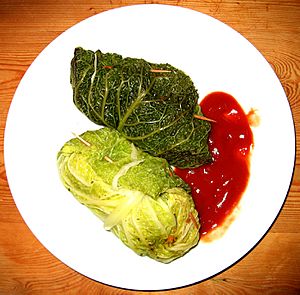
Kåldolmar ("cabbage dolma") are Swedish cabbage rolls. They are filled with rice and minced meat, usually pork. People traditionally eat them with boiled or mashed potatoes, gravy, and lingonberry jam. In Finland, this same dish is known as kaalikääryle.
In 1709, after a battle, the Swedish King Charles XII of Sweden went to the Ottoman town of Bender. He stayed there for over five years. When he returned to Sweden in 1715, some Ottoman cooks came with him. It is believed that Ottoman-style dolma (stuffed dishes) were brought to Swedish cooking during this time.
The name kåldolmar shows its connection to the Turkish word "dolma," which means "filled." Swedish is the only European language that uses a Turkish word for cabbage rolls.
The oldest known Swedish recipe for "Dolma" is from a cookbook in 1765. It suggested using vine leaves, lamb, rice, and lemon juice. But it also said that if you couldn't get vine leaves, you could use pre-boiled cabbage leaves instead. Today, frozen kåldolmar made with cabbage leaves are sold in most stores in Sweden.
To celebrate the cultural exchange between Sweden and the Ottoman Empire, Cabbage Dolma Day (Kåldolmens dag) is celebrated on November 30. This is the day King Charles XII died. The celebration started in 2010. It aims to remember Sweden's diverse cultural heritage. Since 2013, the Swedish History Museum in Stockholm has hosted the event.
Cabbage Rolls in Africa
Egypt
In Egyptian cuisine, cabbage rolls are called maḥshī kromb or maḥshī koronb. This means "stuffed cabbage." The leaves are fresh and often cut into smaller pieces. They are partly cooked beforehand. The most common filling is a mix of rice, onion, tomato, herbs, and spices. Mint, dill, and cumin are often used. Meat is rarely added to Egyptian stuffed cabbage. The rolls are placed in a pot and boiled in broth or a tomato-based sauce. Because the cabbage pieces are small, the rolls are usually shaped like small cigars. The ends are left open, not folded in.
Cabbage Rolls in the Americas
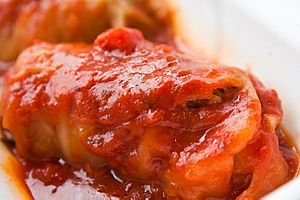
United States
In areas of the United States with many Polish immigrants, like Chicago, Detroit, and parts of Ohio, "cabbage rolls" usually mean stuffed cabbage rolls, like the Polish gołąbki. They are also sometimes called pigs in a blanket. Jewish immigrants from Eastern Europe made the dish popular in New York City. There, they became known as Jewish cabbage.
Cabbage rolls are also important in the cooking of Cajuns and Louisiana Creoles in southern Louisiana. They usually have ground pork mixed with rice and chopped vegetables. This is stuffed into partly boiled cabbage leaves. Then, they are cooked in a tomato sauce-based liquid. Romani Americans often cook cabbage rolls too.
Cabbage Rolls in Asia
China
In Chinese cuisine, cabbage rolls are called 白菜卷, or báicài juǎn.
|
See also
 In Spanish: Col rellena para niños
In Spanish: Col rellena para niños


